Atomic torpedo and multipurpose submarines. 971 project
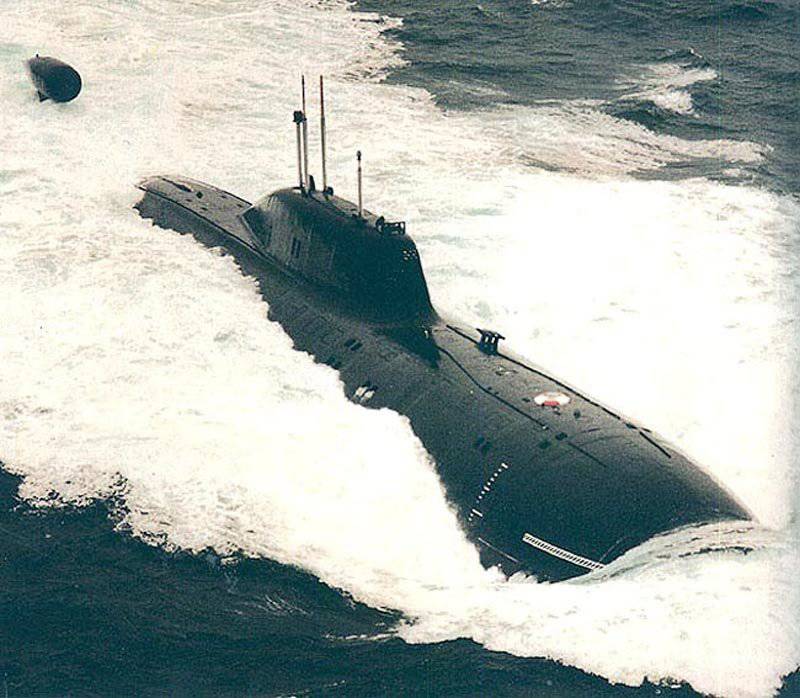
A feature of the new nuclear submarine, the development of which was assigned to the Malachite (Leningrad), was a significant reduction in noise, which is approximately 5 times smaller compared to the most sophisticated Soviet torpedo boats of the second generation. It was supposed to reach this level due to the implementation of the early work of the designers of the SLE in the area of increasing the secrecy of boats (in SLE in the 1970-ies a super-low-noise nuclear submarine was developed), as well as research by the specialists of the Central Research Institute for them. Krylov.
The efforts of the submarine developers were crowned with success: in terms of secrecy, for the first time in stories submarine USSR surpassed the best analogue of American production - multipurpose nuclear submarine of the third generation of the "Los Angeles".
The submarine of the 971 project was equipped with powerful percussion weapons, which significantly surpassed (in missile-torpedo ammunition, caliber and number of torpedo tubes) the potentials of Soviet and foreign submarines of a similar purpose. The new submarine, like the ship of the 945-th project, was designed to fight against the ship’s factions and submarines of the enemy. The boat can take part in the conduct of special operations, mine set and conduct reconnaissance.
13.09.1977 approved the Pike-B technical project. Later, however, he was subjected to revision caused by the need to increase the technological level of the SJC to the level of US submarines (the US in this area once again forged ahead). On the Los Angeles submarines (third generation), the AN / BQQ-5 hydroacoustic complex was installed, which has digital information processing that provides a more accurate selection against the background of interference from the useful signal. Another new "introductory", which necessitated the introduction of changes, was the requirement of the military to install strategic submarines KR Granat on the submarine.
During the revision (completed in 1980), the submarine received a new digital sonar complex with improved characteristics, as well as an armament control system that allows the use of Granat cruise missiles.
The design of a nuclear submarine 971-year project implemented innovative solutions, such as integrated automation and technical means of combat submarine, ship management focus, arms and weapons in a single center - GCP (main command post), the use of pop-up rescue chamber (has been successfully tested on submarines 705 project).
The submarine 971-th project refers to the double-hulled submarines. The robust case is made of high-strength steel (yield strength is 100 kgf / mm2). The main equipment, cutting and battle stations, the main command post located in the zone depreciated units, which represent the spatial frame construction with deck. The acoustic field of the ship significantly reduced depreciation, which allows you to protect the equipment and the crew from dynamic overloads that occur during underwater explosions. Also, the block layout made it possible to rationalize the construction process of the submarine: the equipment installation was transferred from the compartment conditions (rather cramped) to the workshop, to the zone unit accessible from various sides. After installation, the zone unit is “rolled” into the submarine hull and connected to pipelines and trunk cables of the ship systems.
On nuclear submarines, a developed system of two-stage depreciation was used, which significantly reduced structural noise. The mechanisms are installed on the depreciated foundations. All zonal blocks from the submarine hull are insulated with rubber-cord pneumatic shock absorbers that form the second stage of vibration isolation.
Thanks to the introduction of integrated automation, the submarine crew was able to be reduced to 73 people (of which 31 is an officer). This is almost half the size of the Los Angeles nuclear submarine crew (141 people). On the new ship in comparison with nuclear submarines of the project 671РТМ conditions of habitability are improved.
The power plant of the submarine includes the X-NUMX-megawatt OK-190B thermal neutron water-water reactor, which has four steam generators (for the 650 and 1 circuits for a pair of circulating pumps, for the 4 circuit, three pumps) and a single-block steam steam turbine for the saltwater turbine; wide reservation of mechanization. On the shaft, the power was 3 thousand hp.
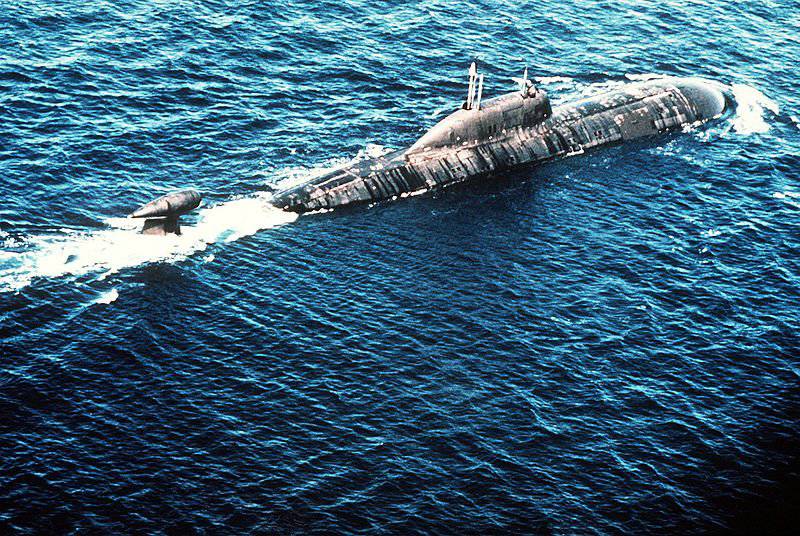
Installed a pair of alternating current turbogenerators. DC consumers are powered by two groups of batteries and two reversible converters.
The submarine is equipped with a seven-blade propeller having a reduced rotational speed and improved sonar characteristics.
In the event of failure of the main power plant for its subsequent input, there are auxiliary means of movement and emergency sources of energy — two thrusters and a rowing dc electric motors each with an 410 hp power. Auxiliary facilities provide the speed of 5 nodes and serve for maneuvering in a limited area.
On board the submarine there are two diesel generators DG-300 with 750 horsepower with reversible converters, fuel for ten days of work. The generators were designed to generate alternating current — they feed general ship consumers and direct current — to power the rowing motors.
GAK MGK-540 "Skat-3", which has a digital data processing system with a powerful system of sonar and noise-finding. The hydroacoustic complex consists of a developed fore antenna, two long-side airborne antennas and a towed extended antenna placed in a container mounted on vertical tail.
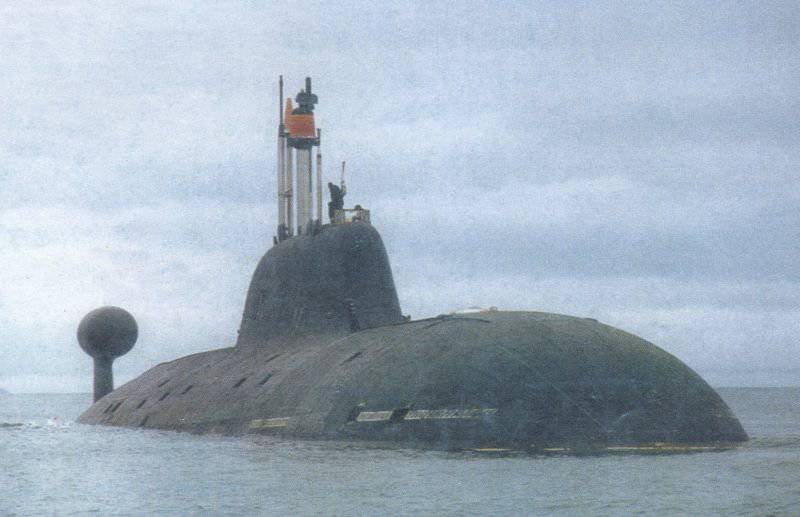
The maximum target detection range through the new complex has increased by 3 times compared with the sonar systems installed on the second generation submarines. Significantly decreased the time for determining the target movement parameter.
In addition to the hydroacoustic complex, nuclear submarines of the 971 project are equipped with a highly efficient system for detecting submarines and surface ships along the wake (the equipment installed on the boat allows the trail to be fixed within a few hours after passing the enemy submarine).
On the boat, the Symphony-U (navigation) and Molniya-MTs (radio communication complex) complexes, which have a towed antenna and the Tsunami space communications system, are installed.
The torpedo-missile system consists of 4 TA caliber 533 millimeters and 4 apparatus caliber 650 millimeters (total ammunition - 40 units of weapons, including 28 533-millimeter). It is adapted for firing the KR "Granat", underwater missile-torpedoes ("Wind", "Squall" and "Waterfall") and missiles, self-transported mines and torpedoes. In addition, the submarine is able to produce conventional mines. Fire control when using Granat cruise missiles is carried out by hardware spec. complex.
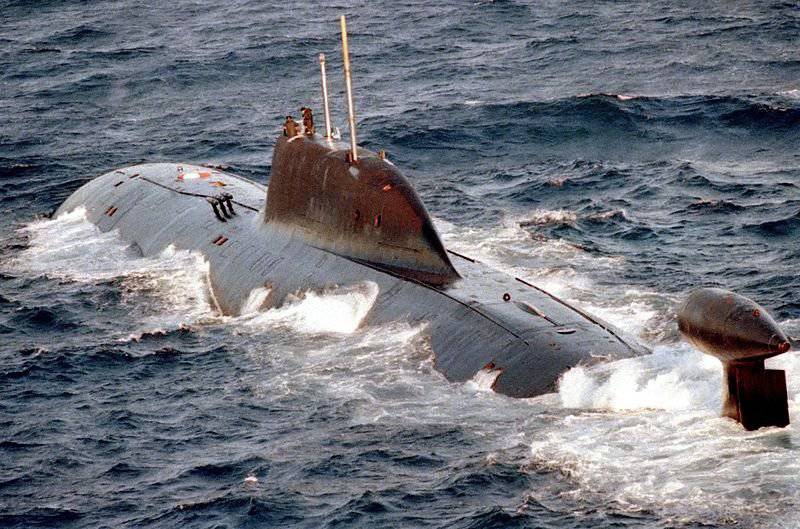
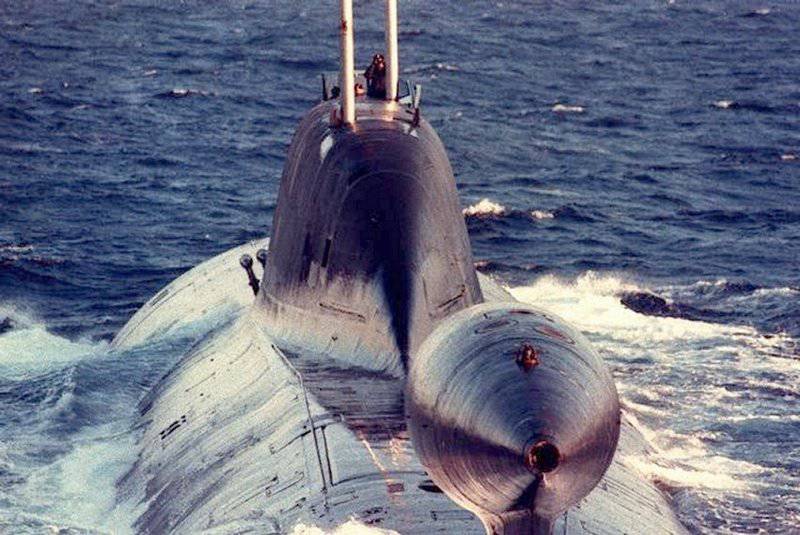
In the 1990-ies, the UGTS (Universal Deep-Water Homing Torpedo), developed at the Research Institute of Marine Heat Engineering and the State Research and Production Enterprise Region, entered the nuclear submarine. She replaced the electric anti-submarine torpedoes TEST-71M and the high-speed anti-ship torpedoes 53-65K. The purpose of the new torpedo was the defeat of the surface ships and submarines of the enemy. A significant fuel reserve and a powerful thermal power plant provide the torpedo with a large range of depths of travel and the possibility of defeating high-speed targets over long distances. The low noise jet propulsion and axial-piston engine (unitary fuel is used) enable the universal deep-water self-guided torpedo to develop speed over 50 nodes. A propeller that does not have a gearbox is directly connected to the engine, which, together with other measures, should significantly increase the secrecy of using a torpedo.
The UGST uses two-plane rudders, which are advanced for bypasses after the torpedo leaves the torpedo tube. Combined acoustic homing equipment has modes for locating underwater targets and searching for surface ships in the wake of a ship. There is a wired remote control system (torpedo coil length 25 thousand m). The complex of onboard processors ensures reliable control of the torpedo systems during the search and destruction of targets. The original solution - the presence of the algorithm "Tablet" in the guidance system. The “tablet” models a tactical picture at the moment of firing on board torpedoes, which is superimposed on the digital picture of the water area (depths, fairways, bottom relief). After the shot, the data is updated from the carrier. Modern algorithms give torpedoes the properties of a system that has artificial intelligence, allowing you to simultaneously use several torpedoes for several or one target during active opposition of the enemy or with a complex target environment.
The length of the universal deep-water self-guided torpedo is 7200 mm, weight is 2200 kg, weight of explosives is 200 kg, travel speed —50 knots, depth of travel —500 meters, firing range — 50 thousand meters.
The development of rocket-torpedoes of the nuclear submarines of the 971 project is also continuing. To date, rocket-torpedoes are equipped with a second stage, which is an APR-3M underwater missile (weight 450 kg, caliber 355 mm, weight of warhead 76 kg), which has a sonar homing system, with a radius of capture 2 thousand. adaptive lead angle made it possible to shift the center of the group of missiles to the middle of underwater targets. The torpedo uses an adjustable turbo-jet engine on a high-calorie mixed fuel, which provides the APR-3M with a significant approach speed with a goal that complicates the use of hydroacoustic countermeasures by the enemy. The underwater speed is from 18 to 30 meters per second, the maximum depth of destruction of targets is 800 meters, the probability of hitting a target is 0,9 (with a mean-square target targeting error from 300 to 500 meters).
At the same time, on the basis of treaties between the USSR and the USA, signed in 1989, weapons systems that have nuclear equipment, the Squall and Waterfall missile-torpedoes, as well as Granat type cruise missiles, were excluded from armament of multi-purpose nuclear submarines.
The Shchuka-B submarine is the first type of multi-purpose submarine, the serial construction of which was originally organized not in Leningrad or Severodvinsk, but in Komsomolsk-on-Amur, which indicated an increased level of development of this branch in the Far East. The head nuclear ship of the 971 project, K-284, was laid in 1980 on the banks of the Amur River and the 30.12.1984 was commissioned. Already in the process of testing this vessel, a higher level of acoustic secrecy was demonstrated. The K-284 noise level in 4-4,5 times (12-15 dB) was lower than the noise level of the most "quiet" Soviet submarine of the previous generation - 671РТМ. This made the USSR the leader in this most important indicator of submarines.
Characteristics of the nuclear submarine project 971:
The greatest length - 110,3 m;
The greatest width - 13,6 m;
Average draft - 9,7 m;
Normal displacement - 8140 m3;
Full displacement - 12770 m3;
Immersion depth - 520 m;
Extreme depth of immersion - 600 m;
Full submerged speed - node 33,0;
Surface speed - 11,6 nodes;
Autonomy - 100 days;
Crew - 73 person.
During serial construction, continuous improvement of the design of the submarine was carried out, acoustic testing was carried out. This made it possible to strengthen the achieved position in the area of secrecy, eliminating the superiority of the United States.
According to the NATO classification, new nuclear submarines received the designation Akula (which caused confusion, since the letter “A” started the name of another USSR submarine - Alfa 705 of the project). After the first "Shark" appeared ships, which in the West were called Improved Akula (among them, probably, were submarines built in Severodvinsk, as well as the last ships of "Komsomol" built). Compared to its predecessors, the new submarines had a better secretiveness than the improved SSN-688-I (Los Angeles) submarines of the US Navy.
Initially, boats of the 971th project carried only tactical numbers. But 10.10.1990/XNUMX/XNUMX an order was issued by the commander-in-chief of the naval fleet Chernavin about assigning the name "Panther" to the submarine K-317. In the future, other nuclear-powered ships of the project received names. K-480 - the first "Severodvinsk" boat - received the name "Bars", which soon became a household name for all submarines of the 971th project. The first commander of Bars is the captain of the second rank Efremenko. At the request of Tatarstan in December 1997, the Bars submarine was renamed the Ak-Bars.
The cruising nuclear submarine (KAPL) "Vepr" built in Severodvinsk was commissioned in the 1996 year. Keeping the former lines, the submarine had a new internal "stuffing" and the design of a solid hull. In the field of noise reduction, another serious leap forward was also made. In the West, this submarine ship (as well as subsequent ships of the project 971) was called Akula-2.
According to the chief designer of the project Chernyshev (who passed away in July 1997), Bars retains significant modernization opportunities. For example, the backlog that Malachite possesses makes it possible to increase the search potential of a submarine approximately 3 times.
According to the American naval intelligence, in the robust case of the modernized Barca there is an insert length of 4 meters. Additional tonnage allowed the submarine to be equipped with “active” vibration reduction systems of the power plant, almost completely eliminating the effect of vibration on the hull. According to expert estimates, according to the stealth characteristics, the upgraded 971 submarine is approaching the level of the fourth-generation multi-purpose submarine SSN-21 "Civulf" of the US Navy. According to the depth of the dive, speed characteristics and armament, these submarines are approximately equivalent. Thus, an improved nuclear submarine project 971 can be considered as a submarine, close to the level of the fourth generation.
Submarines project 971 made in Komsomolsk-on-Amur:
K-284 "Shark" - bookmark - 1980 g .; launching - 06.10.82; commissioning - 30.12.84.
K-263 "Dolphin" - bookmark - 1981 g .; launching - 15.07.84; Commissioning - December 1985
K-322 "Sperm Whale" - bookmark - 1982 g .; launching - 1985 g .; commissioning - 1986 g.
K-391 "Kit" - bookmark - 1982 g .; launching - 1985 g .; commissioning - 1987 (in 1997, the boat was renamed KAPL K-391 “Bratsk”).
К-331 "Narwhal" - bookmark - 1983 g .; launching - 1986 g .; commissioning - 1989 g.
K-419 "Walrus" - bookmark - 1984 g .; launching - 1989 g .; commissioning - 1992 g. (In January 1998, by order of the Navy Civil Code, K-419 was renamed to K-419 “Kuzbass”).
K-295 "Dragon" - bookmark - 1985 g .; launching - 15.07.94; 1996 d. commissioned (1 May 1998, the Dragon submarine was handed over to the Andrewevsky guard flag of the K-133 nuclear submarine, and the Nerpa under construction to the X-NNXX submarine - to the Andrewevsky guard K-152. renamed the cruiser nuclear submarine K-56 "Samara").
K-152 "Nerpa" - bookmark - 1986; launching - 1998; commissioning - 2002
Submarines project 971 made in Severodvinsk:
K-480 "Bars" - bookmark - 1986 g .; launching - 1988 g .; Commissioning - December 1989
K-317 "Panther" - bookmark - November 1986 g .; launching - May 1990; commissioning - 30.12.90.
K-461 "Wolf" - bookmark - 1986 g .; launching - 11.06.91; commissioning - 27.12.92.
K-328 "Leopard" - bookmark - November 1988 g .; launching - 06.10.92; commissioning - 15.01.93. (In 1997, the cruising submarine Leopard handed over the Order of the Red Banner. Some publications say that 29 of April 1991 g inherited the Red Banner Naval Flag from the 181 nuclear submarine of the X-NUMX).
K-154 "Tiger" - bookmark - 1989 g .; launching - 10.07.93; commissioning - 05.12.94.
K-157 “Wild boar” - bookmark - 1991 g .; launching - 10.12.94; commissioning - 08.01.96.
K-335 "Cheetah" - bookmark - 1992 g .; launching - 1999 g .; commissioning - 2000 g. (From 1997 year - Guards KAPL).
K-337 "Cougar" - tab - 1993 g .; launching - 2000 g .; commissioning - 2001 g.
K-333 "Lynx" - bookmark - 1993 g .; removed from construction due to lack of funding in 1997.
The Barses in the Northern Fleet are consolidated into a division based in Yagelnaya Bay. In particular, the wolf nuclear submarine in December 1995 - February 1996 (on board was the crew of the nuclear submarine "Panther" under the command of the captain of the first rank Spravtsev, the senior on board - the deputy commander of the division captain of the first rank Korolev), while in the Mediterranean the sea in combat service, carried out long-range anti-submarine support of the heavy aircraft carrier cruiser Admiral of the Fleet of the Soviet Union Kuznetsov. At the same time, they carried out a long tracking of several NATO submarines, including the American nuclear submarine of the Los Angeles type.
Combat stability and high secrecy give Bars the opportunity to overcome anti-submarine frontiers, which are equipped with stationary systems for long-range sonar surveillance and have anti-submarine resistance. The Leopards can work in the enemy's domination zone, launching sensitive torpedo and rocket attacks on it. The armament of submarines allows you to deal with surface ships and submarines, as well as to hit with high accuracy ground objects when using cruise missiles.
Each boat of the 971 project in the event of an armed conflict can pose a threat, as well as pin down a significant grouping of the enemy, preventing attacks on the territory of Russia.
According to scientists from the Moscow Institute of Physics and Technology, given in the brochure “The Future of Russia's Strategic Nuclear Forces: Discussion and Arguments” (Dolnoprudny 1995 year), even in the most favorable hydrological conditions that are characteristic of the Barents Sea during the winter period 971 can be detected by American “Los Angeles” type submarines with the AN / BQQ-5 hydroacoustic complex at a distance of up to 10 thousand meters. In the case of less favorable conditions in this area, the Bars GAS can hardly be detected possible
The appearance of submarines with such high combat qualities changed the situation and forced the US Navy to reckon with the possibility of significant opposition from the Russian fleet, even under the condition that the US offensive forces were completely superior. The Leopards can attack not only the strike forces of the US Navy, but also their rear, including supply and home points, coast control centers, no matter what distance they are located. Concealed, and therefore inaccessible to the enemy, the nuclear submarines of the 971 project turn a potential war on the ocean into a kind of offensive through a minefield, where any attempt to move forward presents an invisible, but real, danger.
It is appropriate to give a description of the 971 submarines, given by N. Polmar, a prominent US naval analyst, during hearings on the nat committee. security of the United States House of Representatives: "The emergence of Akula-type submarines and other third-generation Russian nuclear submarines demonstrated that the shipbuilders of the USSR liquidated the noise level faster than expected." In 1994, it became known that this gap was completely eliminated.
According to representatives of the US Navy, at operational speeds around 5-7 nodes, the noise level of Improved Akula boats, which was recorded by sonar intelligence, was lower than that of the most sophisticated atomic submarines of the United States Naval Forces Los Angeles. According to Admiral Jeremy Boorda, chief of the operations department of the US Navy, US ships were unable to accompany Akula submarines at a speed of less than 9 nodes (contact with the new Russian submarine took place in the spring of 1995 near the east coast of the United States). The advanced nuclear submarine Akula-2, according to the admiral, according to the low-noise characteristics meets the requirements put forward to the fourth-generation boats.
The appearance in the fleet of Russia after the end of the "cold war" of new super-hidden submarines caused serious concern in the United States. This issue in 1991 year raised in Congress. Several proposals were made for discussion by US lawmakers, which were aimed at rectifying the current situation in favor of the United States of America. In particular, in accordance with them it was assumed:
- demand that Russia give publicity long-term programs in the construction of submarines;
- establish agreed limits on the number of multi-purpose nuclear submarines for the United States and the Russian Federation;
- to assist Russia in refurbishing shipyards that build nuclear submarines for the production of non-military products.
The nongovernmental international environmental organization Greenpeace, which actively supported the prohibition of submarines with nuclear power plants, joined the anti-submarine-fighting company of Russia (of course, this concerned, first of all, Russian submarines, which the greatest environmental hazard). Greenpeace, with a view to "excluding a nuclear catastrophe," recommended that the governments of Western countries deliver a financial provision. assistance to Russia, depending on the solution of this issue.
However, the rate of replenishment of the navy with new multi-purpose submarines sharply declined by the middle of the 1990-ies, which removed the urgency for the United States, although the efforts of the “greens” (as is known, many of which are closely linked to NATO intelligence) , did not stop even today.
Currently, the multi-purpose nuclear submarines of the 971 project are part of the Pacific (Rybachy) and Northern (Yagelnaya Bay) fleets. They are actively used for combat service.
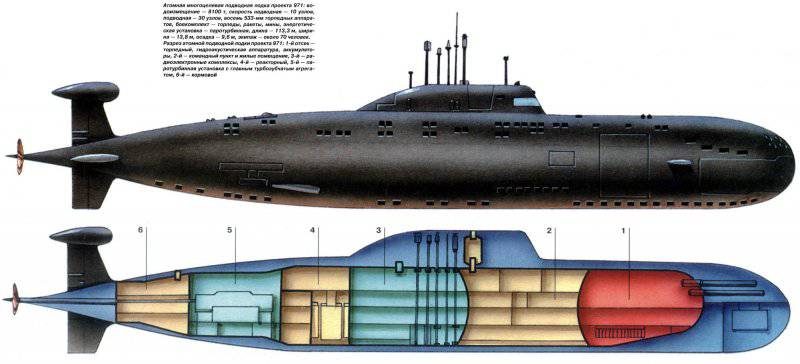
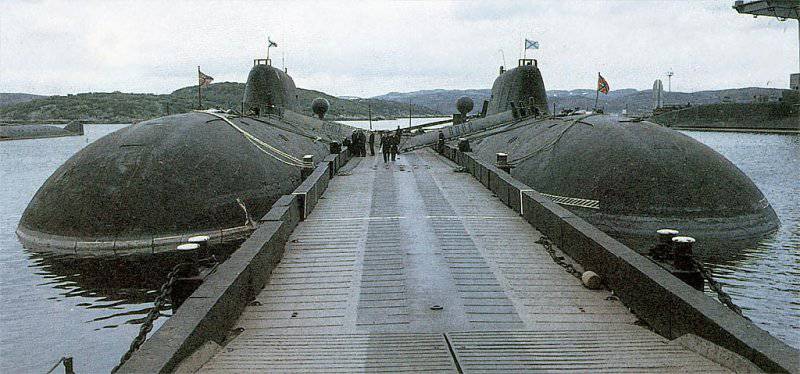

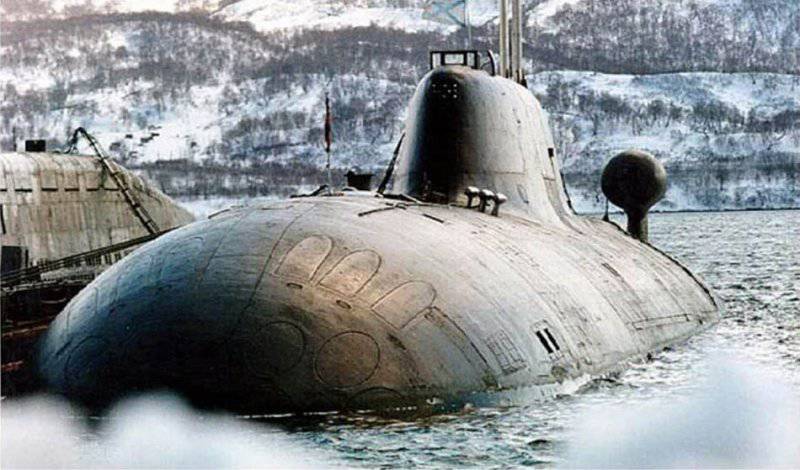
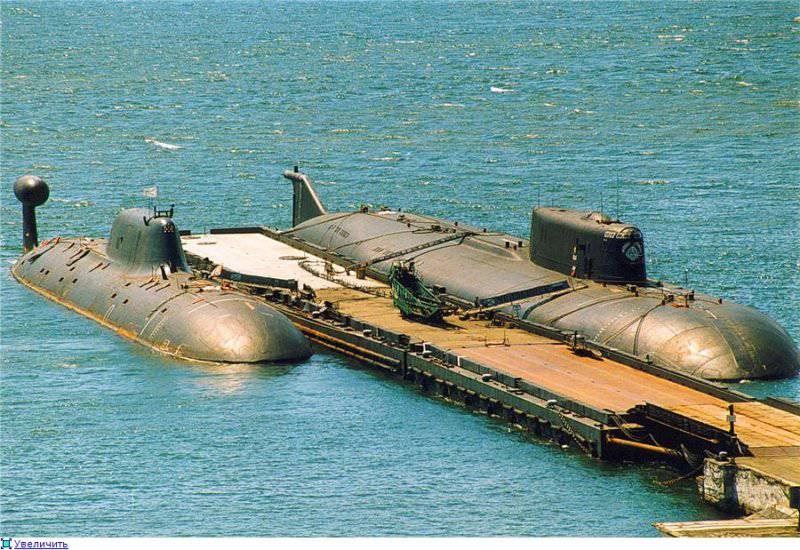
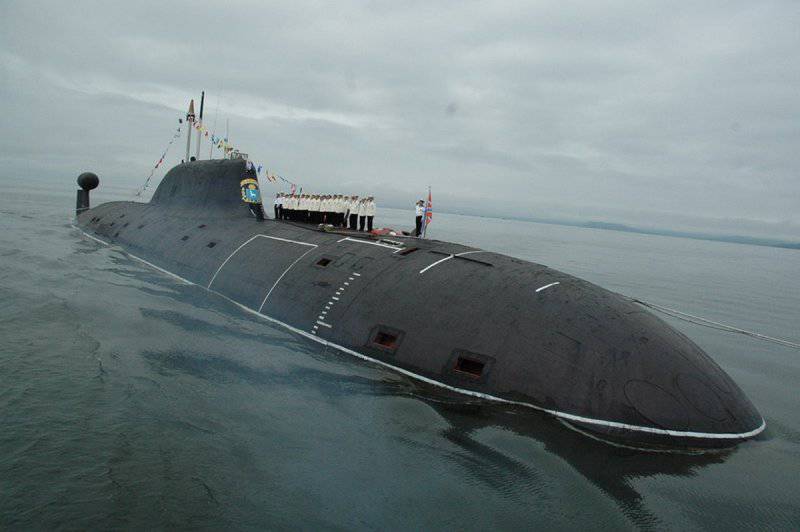
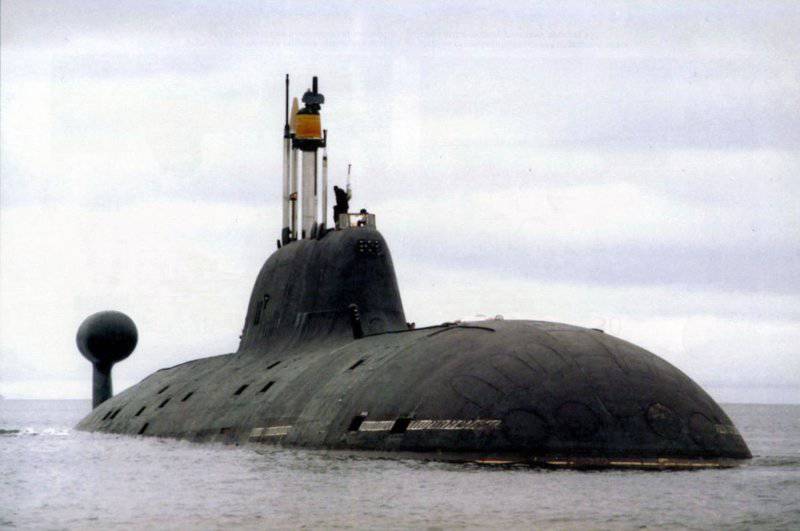
Information